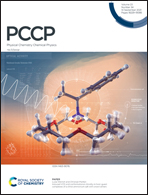Assessing the oxygen reduction reaction by a 2-electron mechanism on ceria surfaces†
Abstract
The 2-electron pathway of the oxygen reduction reaction is an unwanted process in the development of fuel cells. In contrast, it has gained the scientific community's attention due to its importance as a promising way of removing emergent pollutants and endocrine disruptors from water bodies and a more sustainable alternative for large-scale commercial hydrogen peroxide production. Cerium oxide has shown remarkable potential and selectivity experimentally for this mechanism, and its possible applications, exceeding the previous reference materials. In this work, we studied the 2-electron pathway for oxygen reduction on different ceria-cleaving directions (100), (110), (221), and (331) by first principles methods based on density functional theory. Our results show that the (100) surface is the most favorable for reduction, with the (331) crystallographic plane also showing potential for good catalytic activity. This fact could be essential for designing new nanostructures, with higher portions of those planes exposed, for higher catalytic activity.



 Please wait while we load your content...
Please wait while we load your content...